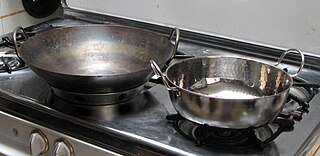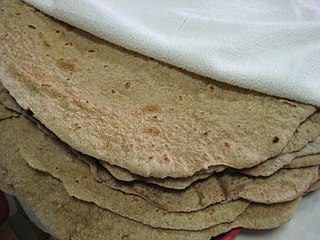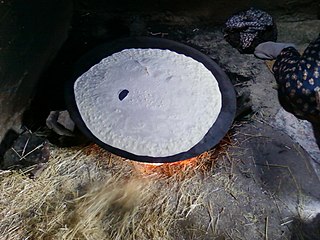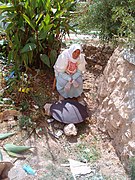
A wok is a deep round-bottomed cooking pan from China. It is believed to be derived from the South Asian karahi. It is common in that country, and similar pans are found in parts of East, South and Southeast Asia, as well as being popular in other parts of the world.

Chapati, also known as roti, rooti, rotli, rotta, safati, shabaati, phulka, chapo, sada roti, poli, and roshi. is an unleavened flatbread originating from the Indian subcontinent and is a staple in India, Nepal, Bangladesh, Pakistan, Sri Lanka, East Africa, the Arabian Peninsula and the Caribbean. Chapatis are made of whole-wheat flour known as atta, mixed into dough with water, oil (optional), salt (optional) in a mixing utensil called a parat, and are cooked on a tava.

A griddle, in the UK also called a girdle, is a cooking device consisting mainly of a broad, usually flat cooking surface. Nowadays it can be either a movable metal pan- or plate-like utensil, a flat heated cooking surface built into a stove or kitchen range, or a compact cooking machine with its own heating system attached to an integrated griddle acting as a cooktop.

Naan is a leavened, oven-baked or tawa-fried flatbread which is found in the cuisines mainly of Iranian, Afghanistan, Central Asia, the Indian subcontinent, Indonesia, Malaysia, Myanmar, and the Caribbean.

Roti is a round flatbread native to the Indian subcontinent. It is commonly consumed in many South Asian countries.

Pakistani cuisine can be characterised as a vibrant blend of regional cooking styles and flavours from across South, Central and Western Asia, as well as ingredients, recipes and techniques borrowed from the Indian Subcontinent, Persian cuisine and Arab cuisine. The cuisine of Pakistan also maintains certain Mughal influences within its recipes and techniques. The country's various cuisines are varied from place to place, with its ethnic and cultural diversity, as well as diverse climates and geographical environments, and availability of different produce options.

Punjabi cuisine is a culinary style originating in the Punjab, a region in the northern part of South Asia, which is now divided in an Indian part to the east and a Pakistani part to the west. This cuisine has a rich tradition of many distinct and local ways of cooking.

A flatbread is a bread made with flour; water, milk, yogurt, or other liquid; and salt, and then thoroughly rolled into flattened dough. Many flatbreads are unleavened, although some are leavened, such as pita bread.

A karahi is a type of thick, circular, and deep cooking pot that originated in the Indian subcontinent. It is used in Indian, Nepalese, Sri Lankan, Pakistani, Bangladeshi/Bengali, Afghan, and the Caribbean cuisines. Traditionally press-formed from mild steel sheet or made of wrought iron, a karahi resembles a wok with steeper sides. Today, they can be made of stainless steel, copper, and nonstick surfaces, both round and flat-bottomed, or of the traditional materials.

Markook bread, also known as khubz ruqaq, shrak, khubz rqeeq, mashrooh, and saj bread, is a kind of Middle Eastern unleavened flatbread common in the Levant and the Arabian peninsula. It is baked on a convex metal griddle or in a tannour.

Indian breads are a wide variety of flatbreads and crêpes which are an integral part of Indian cuisine. Their variation reflects the diversity of Indian culture and food habits.

Sač is a large metal or ceramic lid like a shallow bell with which bread dough or various dishes to be baked are covered, and over which ashes and live coals are placed. Dishes prepared in a sač are evenly cooked, retain their juiciness, and are praised for their rich flavour.

A flattop grill is a cooking appliance that resembles a griddle but performs differently because the heating element is circular rather than straight. This heating technology creates an extremely hot and even cooking surface, as heat spreads in a radial fashion over the surface. Flattop grills have been around for hundreds of years in various forms and evolved in a number of cultures.
Awadhi cuisine is a cuisine native to the Awadh region in Northern India. The cooking patterns of Lucknow are similar to those of Central Asia, the Middle East, and Northern India and western India with the cuisine comprising both vegetarian and non-vegetarian dishes. The Awadh region has been influenced by Mughal cooking techniques, and the cuisine of Lucknow bears similarities to those of Central Asia, Kashmir, Punjab and Hyderabad. The city is also known for its Nawabi foods.

A tandoor is a large urn-shaped oven, usually made of clay, originating from the Indian subcontinent. Since antiquity, tandoors have been used to bake unleavened flatbreads, such as roti and naan, as well as to roast meat. The tandoor is predominantly used in Western Asian, Central Asian, South Asian, and Horn of African cuisines.

Roti canai or roti prata, also known as roti chanai, roti chennai and roti cane, is an Indian flatbread dish found in several countries in Southeast Asia, especially in Brunei, Indonesia, Malaysia, Singapore and Thailand. It is usually served with dal or other types of curry, but can also be cooked in a range of sweet or savoury variations made with a variety of ingredients such as meat, eggs, or cheese.

Paratha is a flatbread native to South Asia, prevalent throughout the modern-day nations of India, Sri Lanka, Pakistan, Nepal, Bangladesh, Maldives, Afghanistan, Myanmar, Malaysia, Singapore, Mauritius, Fiji, Guyana, Suriname, and Trinidad and Tobago where wheat is the traditional staple. Paratha is an amalgamation of the words parat and atta, which literally means layers of cooked dough. Alternative spellings and names include parantha, parauntha, prontha, parontay, paronthi (Punjabi), porota, paratha, porotta, palata, porotha, forota, farata, prata, paratha, buss-up shut, oil roti and Roti Canai in Malaysia.

Saj bread or tava bread is unleavened flatbread in Middle Eastern and South Asian cuisines baked on a metal griddle, called saj in Arabic and tava in the Indian subcontinent.

Arab Indonesian cuisine is characterized by the mixture of Middle Eastern cuisine with local Indonesian-style. Arab Indonesians brought their legacy of Arab cuisine—originally from Hadhramaut, Hejaz and Egypt—and modified some of the dishes with the addition of Indonesian ingredients. The Arabs arrived in the Nusantara archipelago to trade and spread Islam. In Java, since the 18th century AD, most of Arab traders settled on the north coast and diffuse with indigenous, thus affecting the local cuisine culture, especially in the use of mutton meat and ghee in cooking.



























